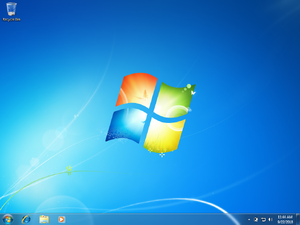QEMU/Guests/Windows 7: Difference between revisions
computernewb>Undefishin No edit summary |
(No difference)
|
Revision as of 10:40, 10 May 2022
< Windows Vista | Windows 8 > | Windows 8.1

Windows 7 is an operating system created by Microsoft, released October 22, 2009. Support ended on January 14, 2020.
Running on CollabVM
Windows 7 works great as a VM for CollabVM. VM 1 on CollabVM runs Windows 7 Ultimate x64 and has been running Windows 7 for around 2 years.
Windows 7 is, however, painfully slow without virtualization, so if you don't have a server with virtualization, you may want to go with Windows XP instead.
Recommended version: Windows 7 Ultimate 64-bit with Service Pack 1
Starting up
QEMU
Pre-installation
Make a qcow2 image (or a raw image if you want) by typing
qemu-img create -f qcow2 win7.img 40G
Windows 7 requires some disk space, you can make this 20 gigabytes if you want but it is recommended to have at least 40 GB for users to install programs onto.
When that's done, run the following command:
qemu-system-i386 -hda win7.img -cdrom win7_iso_name.iso -boot d -enable-kvm -cpu host -m 1G -vga std -net nic,model=rtl8139 -net user -usbdevice tablet -localtime
Or if running without root or virtualization:
qemu-system-i386 -hda win7.img -cdrom win7_iso_name.iso -boot d -cpu qemu64 -m 1G -vga std -net nic,model=rtl8139 -net user -usbdevice tablet -localtime
If you're running 64-bit Windows 7, you're going to want to up the memory up to 2 gigabytes. Windows 7 uses memory better than Vista, although it still performs pretty badly under only 512 MB of RAM. If you're on a server with small resources (but with virtualization), you may want to take a look at Tiny7, which is optimized for lower-end computers.
If you don't have virtualization enabled, then it is highly recommended to go with Tiny7 and turn the Aero theme off. Like Windows Vista, this helps with the load slightly (but not much). To do that in Windows 7, right click the desktop, click "Personalization", select the "Windows Classic" theme, and close the window. Also, if you don't have virtualization enabled, the 64-bit version of Windows DOES work, but is hideously slow, so go with 32-bit Windows 7 instead.
After installation
qemu-system-i386 -hda win7.img -boot c -enable-kvm -cpu host -m 1G -vga std -net nic,model=rtl8139 -net user -usbdevice tablet -localtime
Or if running without root or virtualization:
qemu-system-i386 -hda win7.img -boot c -cpu qemu64 -m 1G -vga std -net nic,model=rtl8139 -net user -usbdevice tablet -localtime